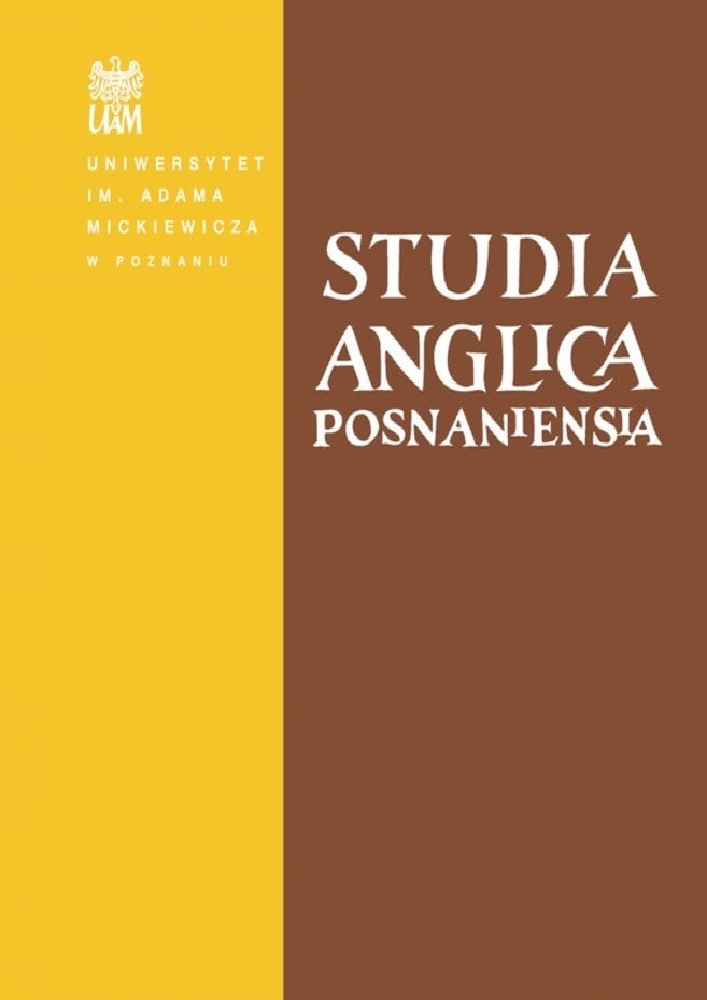Abstract
The present paper focuses on the Middle English preposition twēn(e) ‘between, among, in between’. The aim of the study is to review the acknowledged etymology of twēn(e) as well as to provide its semantics, dialect distribution, complete textual distribution (record of texts employing twēn(e)), and absolute token frequency. Moreover, all texts including the preposition twēn(e) are subject to an analysis of the whole variety of prepositions meaning ‘between’ and their token frequency in order to establish the proportions of the use of twēn(e) and other discussed prepositions, especially the better established preposition betwēn(e) in texts employing twēn(e). The study is based on such extensive electronic databases as the Middle English Dictionary online, the Oxford English Dictionary online and the Corpus of Middle English Prose and Verse as well as on a number of complete Middle English texts. The study of the corpus demonstrates the presence of twēn(e) and other prepositions meaning ‘between’ also in texts not listed by the Middle English Dictionary online or the Oxford English Dictionary online under appropriate entries, and thus helps to provide a more complete record of texts and authors utilizing twēn(e) and the extent of use of twēn(e) as compared to other prepositions meaning ‘between’. Moreover, the study demonstrates that also the other discussed prepositions are often not recorded in particular texts by the MED online or the OED online. In more general terms, the paper points out the need for the use of complete texts for the study of historical prepositions.
References
Alcorn, Rhona. 2013. Distribution of variants of Old English by, for, between. Transactions of the Philological Society 2013. 1-17.
Bergen, Henry (ed.). 1924-1927. Lydgate’s Fall of princes. 4 vols. (Early English Text Society 121-124). London: Oxford University Press.
Ciszek-Kiliszewska, Ewa. 2013. Middle English preposition and adverb twix. Token: A Journal of English Linguistics 2. 75-91.
Ciszek-Kiliszewska, Ewa. 2014. The preposition yēond in Layamon’s Brut. In Michael Bilynsky (ed.), Studies in Middle English: Words, structures, senses and texts, 135-150. Frankfurt/ Main & New York: Peter Lang.
Ciszek-Kiliszewska, Ewa. (in press). Middle English preposition and adverb emell(e). Kwartalnik Neofilologiczny 2014(3).
Hopper, Paul & Elizabeth Closs Traugott. 1993. Grammaticalization. 2nd edn. Cambridge: Cambridge University Press.
Iglesias-Rábade, Luis. 2011. Semantic erosion of Middle English prepositions. Frankfurt/Main etc.: Peter Lang.
Kitson, Peter. 1993. Geographical variation in Old English prepositions and the location of Ælfric’s and other literary dialects. English Studies 74. 1-50.
Kitson, Peter. 1996. The dialect position of the Old English Orosius. Studia Anglica Posnaniensia 30. 3-35.
Krygier, Marcin. 2011. On the Scandinavian origin of the Old English preposition til ‘till’. In Jacek Fisiak & Magdalena Bator (eds.), Foreign influences on Medieval English (Studies in English Medieval Language and Literature 28), 129-138. Frankfurt/Main: Peter Lang.
Kurath, H. et al. 1952-2001. Middle English Dictionary. Ann Arbor: University of Michigan Press.
Lundskær-Nielsen, Tom. 1993 Prepositions in Old and Middle English: A study of prepositional syntax and the semantics of at, in and on in some Old and Middle English texts. Odense: Odense University Press.
MacCracken, H. N. (ed.). 1934. The minor poems of John Lydgate. Vol. 2. (Early English Text Society 192). London: Oxford University Press.
McSparran, Frances (ed.). 1999. The Middle English compendium: The Middle English dictionary. A hyperbibliography of Middle English prose and verse, a Corpus of Middle English Prose and Verse. Ann Arbor: Humanities Text Initiative & University of Michigan.
MED online = Middle English Dictionary. http://ets.umdl.umich.edu/m/med/ Middle English Compendium: The Middle English Dictionary. A hyper bibliography of Middle English Prose and Verse, a Corpus of Middle English Prose and Verse Compiled by Frances McSparran (University of Michigan). Humanities Text Initiative. http://ets.umdl.umich.edu/m/mec/.
Molencki, Rafał. 2005. On the syntactic and semantic development of after in medieval English.
In Marcin Krygier & Liliana Sikorska (eds.), Naked wordes in Englissh (Medieval English Mirror 2), 47-67. Frankfurt/Main: Peter Lang.
Molencki, Rafał. 2007a. On the rise of the temporal preposition/conjunction before. In Marcin Krygier & Liliana Sikorska (eds.), To make his Englissh sweete upon his tonge (Medieval English Mirror 3), 37-54. Frankfurt/Main: Peter Lang.
Molencki, Rafał. 2007b. Rozwój diachroniczny before i after w języku angielskim. In Andrzej Łyda (ed.), Przestrzenie języka, 10-24. Katowice: Wyższa Szkoła Zarządzania Marketingowego i Języków Obcych.
Molencki, Rafał. 2008. The rise of because in Middle English. In Masachiyo Amano, Michiko Ogura & Masayuki Ohkado (eds.), Historical Englishes in varieties of texts and contexts, 201-216. Frankfurt/Main: Peter Lang.
Molencki, Rafał. 2011a. New prepositions and subordinating conjunctions of Romance origin in Middle English. In Jacek Fisiak & Magdalena Bator (eds.), Foreign influences on Medieval English (Studies in English Medieval Language and Literature 28), 9-24.Frankfurt/Main: Peter Lang.
Molencki, Rafał. 2011b. The evolution of forward in Mediaeval English. In Renate Bauer& Ulrike Krischke (eds.), More than words. English lexicography past and present, 225-244. Frankfurt/Main & New York: Peter Lang.
Morris, Richard (ed.). 1865. The story of Genesis and Exodus (Early English Text Society 7).London: Oxford University Press.
OED online - Oxford English Dictionary. http://www.oed.com/
Serjeantson, Mary (ed.). 1938. Bokenham’s Legendys of Hooly Wummen (Early English Text Society 206). London: Oxford University Press.
Steele, Robert (ed.). 1894. Lydgate and Burgh’s Secrees of old philisoffres: A version of the “Secreta secretorum” (Early English Text Society Extra Series 66). London: Kegan Paul, Trench, Trübner & Co.
Steele, Robert (ed.). 1941. The English poems of Charles of Orleans (Early English Text Society 215). London: Oxford University Press.
Traugott, Elizabeth Closs. 1989. On the rise of epistemic meanings in English: An example of subjectification in semantic change. Language 65(1). 31-55.
Traugott, Elizabeth Closs. 1995. Subjectification in grammaticalization. In Dieter Stein & Susan Wright (eds), Subjectivity and subjectivisation: Linguistic perspectives, 31-54. Cambridge: Cambridge University Press.
Traugott, Elizabeth Closs & Richard B. Dasher (eds.). 2002. Regularity in semantic change. Cambridge: Cambridge University Press.
